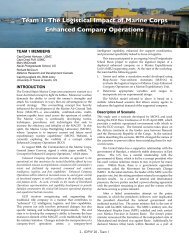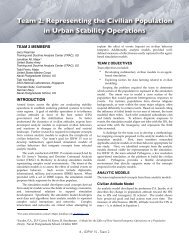pdf file - SEED Center for Data Farming - Naval Postgraduate School
pdf file - SEED Center for Data Farming - Naval Postgraduate School
pdf file - SEED Center for Data Farming - Naval Postgraduate School
Create successful ePaper yourself
Turn your PDF publications into a flip-book with our unique Google optimized e-Paper software.
Manicaland, and the MPF crossed into western Bunduri. The<br />
contested area is shown in Figure 1.<br />
Figure 1: Scenario Area of Operations<br />
The simulation attempts to model ECO-capable Alpha<br />
Company. MPF <strong>for</strong>ces have been kicked out of Alpha<br />
Company’s area of operations (AO), but they continue to<br />
make incursions across the border to influence the local<br />
populace and to harass friendly <strong>for</strong>ces. Since Alpha<br />
Company is the main ef<strong>for</strong>t, they have the luxury of receiving<br />
the priority of support from the MEU’s assets.<br />
The MANA Model<br />
This team began the conference with an initial model<br />
representing Alpha company’s AO already built in MANA<br />
version 5. A screen shot is shown in Figure 2.<br />
Figure 2: Screen shot of initial MANA model<br />
The model background is a topographical map of the<br />
scenario area. The red agents start on the Razie side of the<br />
boarder (denoted by the blue river) and will attempt to make<br />
it to the right most side of the play board. Alpha Company<br />
has three established platoon positions within their AO. At<br />
each position, two squads run patrols, and one squad remains<br />
<strong>for</strong> security. There is also a 60mm mortar team at each platoon<br />
position. As the model runs, the patrolling blue agents will<br />
interdict the red agents when they come into sensor and<br />
weapons ranges.<br />
WORKSHOP RESULTS<br />
The team spent the first day of the workshop familiarizing<br />
themselves with ECO, the scenario, and MANA.<br />
The team spent the second day attempting to incorporate<br />
the scenario logistical aspects into MANA. Our original idea<br />
was to have a supply “tank” at each platoon position that<br />
would hold two days of supply units <strong>for</strong> each blue agent at<br />
that position. Each agent starts with one day of supply, and<br />
returns to the patrol base <strong>for</strong> a resupply when its tank is<br />
empty, so each agent has a total of three days of supply<br />
available at the start of the scenario. When the patrol base<br />
tank is depleted, a resupply agent, the MEU helicopter, flies to<br />
the tank and replenishes the supply units. We attempted to<br />
model this behavior using MANA’s fuel parameter and autorefueller<br />
agents.<br />
Our initial attempt at implementing this scenario had the<br />
agents transition from their default state to a “fuel out” state<br />
when their resources were depleted, and then to a “refuel by<br />
friend” state when they come into contact with the resupply<br />
tank. But this process did not give the desired behavior,<br />
because as each squad entered the “fuel out” state, some of<br />
the agents would immediately transition into the “refuel by<br />
friend” state due to their close proximity to other friendly<br />
agents in the squad. Some agents transferred back to their<br />
default state without receiving any fuel, which then<br />
continued to decrement their fuel parameter below zero,<br />
causing the agent to never enter the “fuel out” state again.<br />
Many different combinations of triggers and trigger states<br />
were attempted in order to get this refueling scenario to work,<br />
but no combination produced the desired result.<br />
The team spent day three trying to create the desired<br />
logistical behavior. This time, instead of using MANA’s<br />
refueling states, we relied on the different sensor and weapon<br />
parameters to trigger when an agent could refuel itself by<br />
using a negative fuel consumption rate. For instance, an<br />
agent starts patrolling with one day of supply units. Once<br />
those units are depleted, that agent changes to a state that is<br />
visible to the resupply tank’s sensor and returns to the base.<br />
When the agent returns to the base, and comes within the<br />
resupply tank’s weapon’s range, it is shot by the tank. The<br />
agent switches into the “shot at” state, refuels itself, and then<br />
continues on its mission. When the tank has fired all of its<br />
ammunition, which is used to represent the tank’s supply<br />
capacity, it changes states into one visible by the resupply<br />
agent (the MEU helicopter), is shot at by the resupply agent,<br />
and reverts back into the default state with a full load of<br />
ammunition (i.e. supplies).<br />
While this algorithm worked in a simplified model,the<br />
desired result could not be achieved with a more complicated<br />
scenario. Our conclusion was that model limitations in the<br />
version of MANA used at the workshop made it unsuitable<br />
<strong>for</strong> this particular study. But after the workshop, Capt<br />
Hinkson contacted one of the MANA developers, Mark<br />
Anderson, who explained that MANA uses a random draw to<br />
determine which agent gets to have its turn first. MANA also<br />
did not implement trigger state changes in the same time step<br />
in which they occurred, which explained the behavior we<br />
observed. Mr. Anderson provided Capt Hinkson with an<br />
updated version of MANA 5 that included instantaneous<br />
state changes. The model now appears to be working as<br />
desired and this version was used in further work to<br />
complete Capt Hinkson’s thesis research.<br />
3 - IDFW 20 - Team 1




